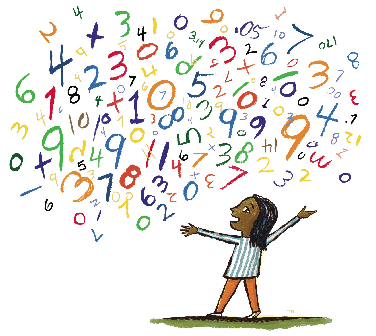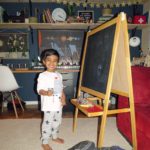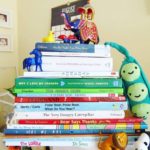Today my daughter is celebrating 100th Day at school. To celebrate this special milestone in a kindergartener’s life, each student was asked to complete a project with their parent at home. The project can be a picture made of 100 things or a collection of 100 things sorted into groups of ten. My daughter was extremely excited to start on her first project which made it that much easier for me. She wanted to do an underwater theme picture, since her latest obsession is Disney’s Ariel and she loves the fish we have at home in our aquarium. While we were working on the project she learned to count by tens to 100 and group the foam stickers we used into groups of ten. She did this with ease and it reminded me of how far she has come in terms of math skills since starting kindergarten.
Here is my daughter proudly showing off her project.
She painted the entire canvas with water colours as well as the Ariel I cut out from her colouring book. She came up with ideas of what to use and came with me to buy all the things we needed. I helped her by cutting out the ocean floor which she glued, writing the numbers, and hot gluing the things onto the canvas. My daughter had a wonderful time working on the project and I was excited that I got to squeeze in a math lesson in at the same time.
Doing this project made me realize how much pre-math concepts is overlooked. Now that I think about it, I definitely spend more time teaching my children reading and writing skills than early math concepts and skills. Since math is one of the most difficult subjects to understand, building strong pre-math concepts are a necessity in ensuring that children succeed at math in elementary school.
Below I have categorized some areas of math and listed activities that I do with my children that you can do with your preschooler, to help him or her understand early math concepts.
Measurement
– During bath time, give your child two liquid measuring cups of different sizes. Ask your child to fill each with water and ask questions such as which cup has less, which has more, which is heavier and which is lighter.
– Ask your child to name some things in the home that your child is taller than and some things that is he or she shorter than. You can also ask your child to name the tallest and shortest person of the family or the tallest object in the room. This will teach your child how to compare heights.
– Cut three to five pieces of yarn and ask your child to point to the shortest yarn and point to the longest yarn. Ask your child to place the yarn in order from shortest to longest and then longest to shortest.
– Help your child understand the basics of time such as knowing when it is morning, afternoon, evening, bedtime, lunchtime, weekend, tomorrow, etc. You can do this simply by using these words daily when you speak.
Patterning
– Use blocks or buttons to do simple colour patterns with your child (red, yellow, red, yellow).
– Form simple shape patterns using cut-out shapes or patterning shapes (square, circle, triangle, square, circle, triangle).
– Once your child has grasped simple patterns more onto more complex ones such as 2 red buttons, 1 blue button, 2 red buttons, 1 blue button.
– Make a pattern out of movement (jump, take 1 step, jump, take 1 step).
– Make a necklace or bracelet using different coloured or shaped chunky beads to form a pattern.
– Learn the 7 days of the week by singing the “Days of the Week Song“. Show your child the calendar and how the 7 days repeat every week.
Sorting
– Ask your child to sort their toys or a bag of buttons by colour or size (small, medium, big). Once your child understand the concept move onto sorting by colour and size (red and small, red and medium, red and big).
– Ask your child to think of animals that live on a farm, things that can fly, things that are red, things that have wheels, etc.
– Ask your child to tell you how many things in the room are heavy, or how many are round, etc.
Number Sense (understanding one-to-one correspondence)
– Draw 5 faces, place a certain amount of googly eyes, and ask your child to find out if he or she needs more googly eyes or less. Let your child place two eyes per face and find out. Repeat with buttons for nose and wool for mouth.
– Make a pattern with blocks. Make exactly the same pattern right below the first with the same number of blocks spaced wider apart. Ask your child if the second pattern has more, less, or the same amount of blocks. Use one to one matching to figure out the answer rather than counting
– Make a pattern. Make exactly the same pattern but with more blocks spaced closer together, so that the length of both patterns are similar. Ask your child if the second pattern has more, less, or the same amount of blocks. Again, allow your child to use one-to-one matching to answer the question.
Numeration
– Teach your child the song “One, Two, Buckle My Shoe”.
– Count 1-10 using toys, stickers, other objects.
– Count each step as you go or up or down the stairs.
– When you give your child fruit, count how many strawberries, grapes, or blueberries he or she has in his or her plate.
– Ask your child to bring you three books, five books, etc. during story-time.
– Match numbers of objects to the numeral. (understand that 4 objects represents the number 4, 8 objects represents 8)
– Talk about series of numbers such as your phone number and house number.
– Talk about the sequence of numbers on the calendar.
Geometry
– Cut out shapes with your child. Let your child feel the cut-out shapes and run his or finger along the edges. Teach the simple shapes: rectangle, square, circle, and triangle. Once your child has mastered these shapes you can move onto shapes such as oval, diamond, trapezoid, and hexagon.
– Make a game out of pointing to shapes you see throughout the day.
– Using the cut-out shapes or shapes from a toy shape shorter, ask your child how many sides each shape has.
– Use cut-out shapes to make pictures that resemble something such as a house, car, or train.
To help your child have a head start in junior kindergarten you can start by teaching him or her the following:
– Simple 2D shapes
– Simple Patterns
– To count numbers from 1-10
– One-to-one correspondence (which group has 3 objects, which group has 4 objects)
– Recognition of numbers by sight
– Quantity (which is more, which is less)
By working on the above activities with your child, you will help him or her develop the underlying concepts of elementary school math.
Feature Image: gophoto.us





